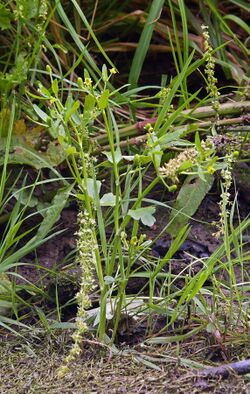Biology:Ranunculus sceleratus
| Ranunculus sceleratus | |
|---|---|

| |
| Scientific classification | |
| Kingdom: | Plantae |
| Clade: | Tracheophytes |
| Clade: | Angiosperms |
| Clade: | Eudicots |
| Order: | Ranunculales |
| Family: | Ranunculaceae |
| Genus: | Ranunculus |
| Species: | R. sceleratus
|
| Binomial name | |
| Ranunculus sceleratus | |
Ranunculus sceleratus known by the common names celery-leaved buttercup,[1] celery-leaf buttercup,[2] and cursed buttercup[3] is a species of flowering plant in the buttercup family Ranunculaceae. It has a circumpolar distribution in the northern hemisphere, native to temperate and boreal North America and Eurasia, where it grows in wet and moist habitats, including ponds and streambanks.
Description
Ranunculus sceleratus is an annual herb growing up to half a meter tall. The leaves are more or less glabrous (hairless) and have small blades each deeply lobed or divided into three leaflets. They are borne on long petioles. The flowers are 5-10mm across with five or fewer yellow petals a few millimeters long and reflexed sepals. The fruit is an achene borne in a cluster of several.[4]:110,114
While buttercups are toxic due to the presence of the substance protoanemonin, this applies in particular for the cursed buttercup: it is the most toxic buttercup and contains 2.5% protoanemonin. When the leaves are wrinkled, damaged or crushed, they bring out unsightly sores and blisters on human skin.
Distribution
Ranunculus sceleratus has a circumpolar distribution in the northern hemisphere[5] There are two varieties and one subspecies[6] with distinctive distributions: R. sceleratus ssp. reptabundus occurs in northern Finland and north-west Russia .[5] R. scleratus var. multifidus occurs in north western North America.[5] and R. scleratus var. longissimus is found from Minnesota to Alabama according to their biodiversity and plant atlases respectively.[citation needed]
References
- ↑ "Ranunculus sceleratus, Celery-leaved buttercup". London: Natural History Museum. http://www.nhm.ac.uk/our-science/data/uk-species/species/ranunculus_sceleratus.html. Retrieved 27 May 2016.
- ↑ Lee, Sangtae; Chang, Kae Sun, eds (2015). English Names for Korean Native Plants. Pocheon: Korea National Arboretum. p. 602. ISBN 978-89-97450-98-5. http://www.forest.go.kr/kna/special/download/English_Names_for_Korean_Native_Plants.pdf. Retrieved 15 March 2019.
- ↑ "Ranunculus sceleratus". Natural Resources Conservation Service PLANTS Database. USDA. https://plants.usda.gov/core/profile?symbol=RASC3. Retrieved 18 Oct 2015.
- ↑ Stace, C. A. (2010). New Flora of the British Isles (Third ed.). Cambridge, U.K.: Cambridge University Press. ISBN 9780521707725.
- ↑ Jump up to: 5.0 5.1 5.2 Anderberg, Arne. "Ranunculus sceleratus (L.) Sw". Naturhistoriska riksmuseet, Stockholm. http://linnaeus.nrm.se/flora/di/ranuncula/ranun/ranuscev.jpg. Retrieved 27 May 2016.
- ↑ "The Plant List: Ranunculus sceleratus L". Royal Botanic Gardens, Kew and Missouri Botanic Garden. 2013. http://www.theplantlist.org/tpl1.1/record/kew-2526806. Retrieved 27 May 2016.
External links
| Wikimedia Commons has media related to Ranunculus sceleratus. |
- Wedgwood, Hensleigh (1855). "On False Etymologies". Transactions of the Philological Society (6): 65. https://babel.hathitrust.org/cgi/pt?id=uc1.b3924121;view=1up;seq=75.
- Jepson Manual Treatment
- Washington Burke Museum
- Photo gallery
Wikidata ☰ Q1339284 entry
 |



